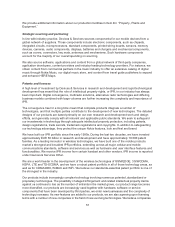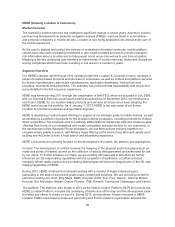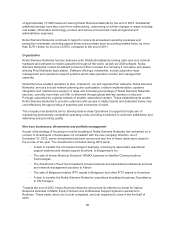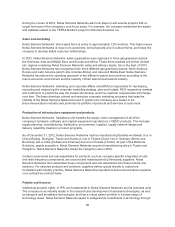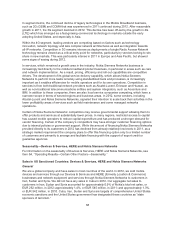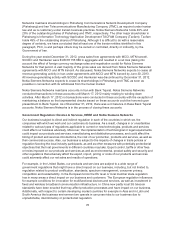Nokia 2012 Annual Report Download - page 67
Download and view the complete annual report
Please find page 67 of the 2012 Nokia annual report below. You can navigate through the pages in the report by either clicking on the pages listed below, or by using the keyword search tool below to find specific information within the annual report.During the course of 2012, Nokia Siemens Networks also took steps to exit several projects that no
longer form part of the company’s core focus areas. For example, the company transferred the assets
and liabilities related to the TETRA Nødnett project to Motorola Solutions Inc.
Sales and marketing
Nokia Siemens Networks’ direct sales force is active in approximately 120 countries. This helps ensure
Nokia Siemens Networks is close to its customers, both physically and in cultural terms, and helps the
company to develop stable customer relationships.
In 2012, Nokia Siemens Networks’ sales organization was organized in three geographical clusters:
the Americas; Asia and Middle East; and Europe and Africa. These three markets are further divided
into regions containing Nokia Siemens Networks’ sales and delivery teams. Since the start of 2013,
Nokia Siemens Networks has reorganized into three different geographical clusters: North America;
Europe and Latin America (which also includes Africa); and Asia and Middle East. Nokia Siemens
Networks has tailored its operating approach in the different regions and countries according to the
macro-economic environment and the maturity of their telecommunications industry.
Nokia Siemens Networks’ marketing and corporate affairs unit (MCA) is responsible for developing,
executing and measuring the corporate marketing strategy, plan and budget. MCA researches markets
and customers to predict the way the market will develop and how customer requirements will change
over time. The team develops content and executes corporate marketing programs that raise the
visibility of the Nokia Siemens Networks brand to position the company as a leader in the
telecommunications industry and promotes its portfolio of products and services to customers.
Production of infrastructure equipment and products
Nokia Siemens Networks’ Operations unit handles the supply chain management of all of the
company’s hardware, software and original equipment manufacturer (“OEM”) products. This includes
supply planning, manufacturing, distribution, procurement, logistics, supply network design and
delivery capability creation in product programs.
As of December 31, 2012, Nokia Siemens Networks had ten manufacturing facilities worldwide: four in
China (Beijing, Shanghai, Tianjin and Suzhou), one in Finland (Oulu), two in Germany (Berlin and
Bruchsal), two in India (Kolkata and Chennai) and one in Russia (Tomsk). As part of the Motorola
Solutions, assets acquisition, Nokia Siemens Networks acquired manufacturing sites in Tianjin and
Hangzhou. Nokia Siemens Networks closed the Hangzhou site in 2012.
Certain components and sub-assemblies for products, such as company specific integrated circuits
and radio frequency components, are sourced and manufactured by third-party suppliers. Nokia
Siemens Networks then assembles these components and sub-assemblies into final products and
solutions. For selected products and solutions, suppliers deliver goods directly to customers.
Consistent with industry practice, Nokia Siemens Networks manufacture telecommunications systems
on a contract-by-contract basis.
Patents and licenses
Intellectual property rights, or IPR, are fundamental to Nokia Siemens Networks and its business units.
The company is an industry leader in the research and development of wireless technologies, as well
as transport and broadband technologies, and has a robust patent portfolio in a broad range of
technology areas. Nokia Siemens Networks seeks to safeguard its investments in technology through
66



